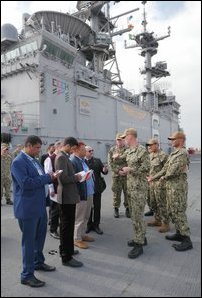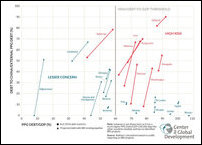
South Asian journalists introduced to US agency-concept in making to fight China's BRI
[TamilNet, Wednesday, 21 November 2018, 20:20 GMT]
One of the eight journalists, who took part in a recent US-orchestrated ‘reporting tour’ posed a question on the Rohingya issue in Myanmar to Brig. Gen. Dagvin Anderson, deputy director for operations of US Indo-Pacific Command (USINDOPACOM) at Hawaii's Honolulu. Declining to comment, Anderson said it was a State Department and national leadership issue. “We are not against the fact that China wants to have a global presence and wants to be involved globally, so long as they don't want to subvert or change a system that has been working very well for the last several decades,” he told Rezaul Karim, the Bangladeshi journalist. The US commander was looking forward to military-to-military engagement with Bangladesh. During their trip, the journalists were introduced to the concept of the new finance agency, the USIDFC, which is being conceived to counter China's Belt and Road Initiative.
The journalists from Bangladesh, India, Nepal and ‘Sri Lanka’ were on a 10-day tour to the USA and were taken to Washington, DC., Los Angeles and San Diego. The tour was organised by the U.S. Department of State's Foreign Press Center. Meetings were held with US officials, think tanks, journalism outlets as well as a visit to the amphibious assault ship USS Bonhomme Richard (LHD 6), where were taken through the hangar bay, well deck and the flight deck.
The tour was titled 'Amplifying the Indo-Pacific Strategy'.
The discussions centred on U.S. geopolitics, military, and economic strategy in the Indo-Pacific concerning China's Belt and Road Initiative (BRI). The USA had a common interest in a “free and open Indo-Pacific strategy,” the South Asian journalists were told.

The journalists from South with Satu Limaye, the director of the East-West Center in Washington [centre], on 24 October 2018. They discussed U.S. geopolitical, military, and economic strategy in the Indo-Pacific in relation to China's One Belt, One Road policy. Two journalists from Colombo, Azhar Razak and Kushan Subasinghe, also took part in the trip [Photo courtesy: East-West Center on Twitter]

South Asian journalists visit amphibious assault ship USS Bonhomme Richard (LHD 6) [Photo courtesy: U.S. Embassy in Colombo]
They were introduced to the concept of a new financial agency in the making, the U.S. International Development Finance Corporation (USIDFC), which is replacing the Overseas Private Investment Corporation (OPIC) of the USA.
The USIDFC is much more prominent in scope than the U.S. Agency for International Development (USAID).
“The USIDFC will catalyze market-based, private-sector development, spur economic growth in less-developed countries, and advance the foreign-policy interests of the United States,” the USAID said in a statement issued on 03 October following the passing of the Better Utilization of Investments Leading to Development (BUILD) Act of 2018.
BUILD with a capacity to invest $60 billion is a move to compete with China's BRI in the Indo-Pacific region.
Principal Deputy Assistant Secretary at the Bureau of South and Central Asian Affairs of the US State Department said that the "projects built by China under BRI have no commercial value,” reports Jagdishor Panday, a journalist from Nepal who took part in the tour.
“This will increase debt, undermining the sovereignty of the country,” she said adding that Nepal could benefit from the BUILD Act.
* * * The Washington-based Centre for Global Development came with a report in March 2018 identifying 23 of 68 countries involved in China's Belt and Road Initiative, as being at the “risk of debt distress”. The 23 countries were categorised as low, significant and high-risk countries.

[Illustration courtesy: Center for Global Development]
Out of these 23 countries, eight were classified as being at high-risk.
Djibouti, the Maldives, Laos, Montenegro, Mongolia, Tajikistan, Kyrgyzstan and Pakistan were the eight high-risk countries.
Five of these eight countries, excluding Montenegro, Djibouti and the Maldives, share land-borders with China.
‘Sri Lanka’, along with Bhutan and Afghanistan was identified by the US-based outfit as the ‘significant’ risk category in South Asia.
“With Sri Lanka unwilling to service a $8 billion loan at 6 per cent interest that was used to finance the construction of the Hambantota Port, China agreed in July 2017 to a debt-for-equity swap accompanied by a 99-year lease for managing the port,” the report said.
“The Sri Lankan government may agree to additional BRI-related financial commitments, but their size is likely to be tempered by the Hambantota Port experience,” the CGI report further noted.
Beijing was also “willing to give” an estimated additional $24 billion as part of BRI, the report noted citing a news item of The Economic Times from 17 May 2017, which was titled "China willing to give Sri Lanka $24 billion more as part of OBOR".
* * * The US-based think tanks have been actively engaged in issuing reports and organising study trips as part of a push to strike a balance with China to favour the USA in the trade war. It is under these circumstances naval hard-power manoeuvres are unfolding in the Indo-Pacific escalating the scenario into a full-fledged cold war.
The USA, fully aware of its inability to match the BRI in financial programmes, is trying to strike a deal with China using the World Trade Organisation, the World Bank and the International Monetary Fund (IMF), a group of outfits set up by the West to rebuild the economies of the West. The triple neoliberal ‘global governing system’ was ‘opening up’ the poverty-stricken countries through offering loans and sophisticatedly exploiting the resources through the corporate outfits.
The bodies created to control the economy and market were pre-occupied with maintaining the world order. They used the notion of terrorism and let their agent states to carry on with the suppression of people who were genuinely fighting for their national freedom.
Thanks to whistleblowers, Eezham Tamils know today how the IMF and World Bank advisers controlled even the US State Department-led politics of human rights during the Obama administration.
Eezham Tamils will always be reminded of the following lines of an email from Burns Strider, a former senior advisor to Ms Hillary Clinton when she was US Secretary of State in 2009:
“My take is that the people on the ground both with World Bank and IMF believe the Tigers need to be completely defeated and any collateral damage inflicted on private people by SL govt in process is ok...”
The genocide-affected Eezham Tamils should also know that the injustices caused by the discourses of the paradigms of the USA and China, and the nature of other actors such as India, would not be in their favour and it is folly to believe that they could be benefited from one side or the other. Those who think so would be locked to an eternal, pointless repetition of rat races.
External Links:
Chronology:











